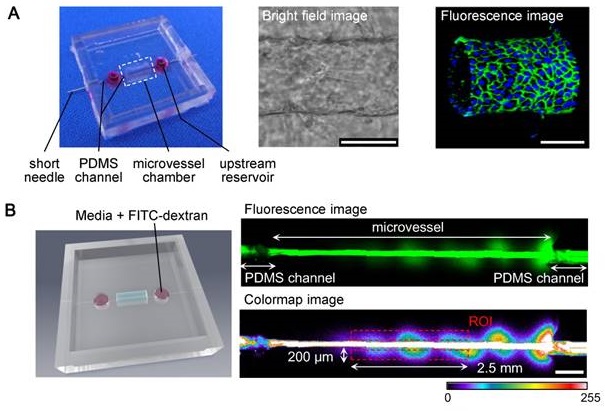Blood vessels exhibit highly regulated barrier function allowing selective passage of macromolecules. And the disorder in barrier function can cause abnormal vascular permeability, which is often associated with various pathological states. There is no realistic in vitro model for measuring vascular permeability because most models are limited to mimicking anatomical structural properties. Here, to study vascular permeability, a method based on the human microvessel-on-a-chip is established at Creative Bioarray to overcome the problem mentioned above and enables the study of compounds that protect the endothelial barrier function.
This assay takes advantage of polydimethylsiloxane (PDMS)-based microchips that include needle inserting channels. The PDMS chip is first treated with O2 plasma for one minute and then sterilized under UV lights for 5 minutes. Next, the iced-cold neutralized collagen solution was added in the three chambers- the two reservoirs and the microvessel chamber. Immediately, an acupuncture needle is inserted within the PDMS channels and the collagen is withdrawn from the two reservoirs. Then, the chip is incubated to allow the collagen to gel. Once the collagen is fully gelled, the needle is withdrawn leaving channel within the collagen. Cells will be seeded near each opening of the collagen channel and then culture medium will be added in the chip to incubate the cells for a proper time. After cells incubated for enough time, the microvessel is stained to enable its visualization by confocal microscopy. The permeability of the microvessel can be visualized and the extent of the vascular permeability can be assessed by this method.
 Figure 1. The schematic diagram of microvessel chip
Figure 1. The schematic diagram of microvessel chip
This vascular permeability assay is reproducible and quantitative, which could monitor endothelial barrier function and permeability to assess the protective effect of compounds. With a PDMA microchip, the microvessel can show mature cell-cell junctions and an effective barrier function. This method is helpful for the studies on reducing the endothelial permeability or strengthening the barrier function of endothelial cells.

Online Inquiry